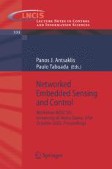Search
Search Results
-
9. Switched Scalable Video Coding Systems
Scalable video coding means that a video sequence is only encoded once and the coded bitstream has the capability of sending any sub-bitstream...
-
4. Stability of Nonlinear Switched and Impulsive Systems
In this chapter, we shall study the stability of nonlinear switched and impulsive systems of the form...
-
1. Examples and Modelling of Switched and Impulsive Systems
When you begin to read this book, you may ask: “what is a switched and impulsive system?” This is a question that may be best answered through...
-
Applications of Connectivity Graph Processes in Networked Sensing and Control
This paper concerns the problem of controlling mobile nodes in a network in such a way that the resulting graph-encoding of the inter-node...
-
Plenary Talk: Delays in Control over Communication Networks: Characterization, Impact, and Reduction Strategies
The most notable trend in manufacturing over the past five years is probably the move towards networks at all levels of industrial systems. At lower...
-
Homogeneous Semantics Preserving Deployments of Heterogeneous Networks of Embedded Systems
Tagged systems provide a denotational semantics for embedded systems. A heterogeneous network of embedded systems can be modeled mathematically by a...
-
Distributed Kalman Filtering and Sensor Fusion in Sensor Networks
The problem of distributed Kalman filtering (DKF) for sensor networks is one of the most fundamental distributed estimation problems for scalable...
-
Simulation of Large-Scale Networked Control Systems Using GTSNetS
This paper presents a simulation framework for distributed control using wireless sensor networks. The proposed framework is an extension of the...
-
Disturbance Attenuation Bounds in the Presence of a Remote Preview
We study the fundamental limits of disturbance attenuation of a networked control scheme, where a remote preview of the disturbance is available. The...
-
Delay-Reliability Tradeoffs in Wireless Networked Control Systems
Networked control systems (NCS) require the data to be communicated timely and reliably. However, random transmission errors incurred by wireless...
-
Plenary Talk: The Role of Information Theory in Communication Constrained Control Systems
Communication is an important component of distributed, networked, and cooperative control systems. In most current systems the communication aspects...
-
Belief Consensus and Distributed Hypothesis Testing in Sensor Networks
In this paper, we address distributed hypothesis testing (DHT) in sensor networks and Bayesian networks using the average-consensus algorithm of...
-
Plenary Talk Network-Embedded Sensing and Control: Applications and Application Requirements
The first part of my talk will cover some recent commercially successful applications of networked and embedded sensing and control solutions. These...
-
2. Analysis of Switched and Impulsive Systems
The analysis will focus on the case where the switchings are governed by a finite state machine. This is because the common Lyapunov function method...
-
3. Stability of Linear Switched and Impulsive Systems
In the previous chapter, we have set up the basic framework for the stability analysis of switched and impulsive systems. The framework provides the...
-
10. Future Research Directions and Potential Applications
Many interesting applications of switched and impulsive systems have been presented in the previous chapters. We shall conclude this book by...
-
Distributed Evidence Filtering in Networked Embedded Systems
Networked embedded sensor systems use the evidence gathered by spatially distributed heterogeneous sensor nodes possessing partial and different...
-
Distributed Control over Failing Channels
We give sufficient convex conditions for the existence of a distributed controller, with the same interconnection structure as the plant, when the...
-
A Cross-Layer Approach to Energy Balancing in Wireless Sensor Networks
We consider a many-to-one real-time sensor network where sensing nodes are to deliver their measurements to a base station under a time constraint...
-
Plenary Talk Notes on Multi-agent Motion Coordination: Models and Algorithms
Motion coordination is an extraordinary phenomenon in biological systems such as schools of fish and serves as a remarkable tool for man-made groups...
